Canning & Preserving
Pressure Canning Fruit & Water Bath Canning
Equipment Preparation Wash and assemble canning equipment, utensils and containers. Make sure you have everything that you need before you start fruit preparation. Once you begin the canning process you need to work as quickly as possible without delays. Ball Canning Jars Use authentic Mason or Ball canner jars. Examine and discard those with nicks, cracks and rough edges. These defects will not permit an air-tight seal. All jars should be washed in hot soapy water, rinsed well and then kept hot. This can be done in a dishwasher or by placing the jars in the water that is heating in your canner. The jars need to be kept hot to prevent breakage when they are filled with a hot product and placed in the kettle for processing. Jars that will be filled with food and processed for less than 10 minutes in a boiling water bath canner need to be sterilized by boiling in water for 10 minutes. NOTE: If you are at an altitude of 1000 feet or more, boil an additional minute for each additional 1000 feet of altitude. (i.e.) 5000 feet=5 minutes longer. Fruit Preparation Gather fruit and vegetables early in the morning when they are at their peak of quality. Do not use over-ripe products. Gather or purchase only as much as you can prepare within 2 or 3 hours. Wash products by either quick soaking and/or rinsing making sure to remove all dirt and sand including any chemicals that may be present. Dirt contains some of the bacteria that are hardest to kill. The cleaner the raw foods, the more effective the preserving process. Do not can decayed or damaged fruit. Do not let the food soak; it will lose flavor and nutrients. Water Bath Canners Fill the kettle with the appropriate amount of hot water and begin heating it on the range. The water bath requires 1 to 2 inches of water above the tops of jars. This can be difficult to determine before the filled jars are in place but after a batch or two you will learn how much water you you have to add. It is always a good idea to have an extra small pot of water heating just in case. 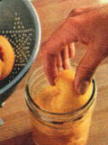 Packing Jars Raw Pack (Cold Pack) Pack raw fruit into jars and cover with boiling hot sugar syrup, juice or water. It is necessary to leave a head space between the lid and the top of food or liquid. This space is needed for the bubbling of liquids  and fruit expansion. If the jars are filled too full the contents may overflow during processing. The amount of head space is usually between 1/8 and 1/2 inch. Check the individual recipe for the exact amount of head space. and fruit expansion. If the jars are filled too full the contents may overflow during processing. The amount of head space is usually between 1/8 and 1/2 inch. Check the individual recipe for the exact amount of head space.Peaches | Apricots | Berries | Cherries | Grapefruit Pears | Plumbs | Blackberries | Raspberries | Elderberries Gooseberries | Huckleberries Top of Page Hot Pack Heat fruit in syrup, in water or over steam before packing. Fruits with a high juice content and tomatoes can be pre-heated without adding liquid and then packed in the juice that cooks out. To Fill Jars Pack each jar to within 1/4 inch of top or as specified in individual recipe. For non-liquid foods(ie. peaches) it is necessary to remove any trapped air bubbles by running a rubber spatula or table knife gently between the solid product and the edge of the jar. Add more hot syrup as needed. Wipe rim and screw threads with a clean damp cloth, place lid on top and screw bands on tightly and evenly to hold rubber sealing lid (or sealing ring) in place. Sometimes it is necessary to position and hold down sealing lid while you tighten the band to insure the lid is centered on the top of the jar. Do not over-tighten. Jars are then ready to be placed on the rack inside hot water canner. Peaches | Apricots | Berries | Cherries | Grapefruit Pears | Plumbs | Blackberries | Raspberries | Elderberries Gooseberries | Huckleberries Top of Page Place jars on rack immediately after packing. Lower filled rack into canner. Jars should be covered by 1 to 2 inches of water. Add additional boiling water if needed. If you add more water, pour between jars and not directly on them (this is where the extra pot of heated water comes in handy). Cover pot with lid. When the water comes to a rolling boil, start to count the processing time. Boil gently and steadily for the time recommended for the food being processed. When the cooking time is up, remove jars at once and place on a rack or on towels away from heat and away from any draft. Peaches | Apricots | Berries | Cherries | Grapefruit Pears | Plumbs | Blackberries | Raspberries | Elderberries Gooseberries | Huckleberries Top of Page Test for Seal After jars have cooled between 12 and 24 hours after processing, check seal. To do this press down on the center of the lid. The lid should be con-caved and not move when pressed. Another method is to tap the lid with the bottom of a teaspoon. If the jar is sealed correctly, it will make a high-pitched sound. If it makes a dull sound it means the lid is not sealed or possibly that food is in contact with the underside of the lid. Do not be alarmed if during the first the first hour or so of cooling if you hear a popping sound come from the jars. This is a good sound to hear as it most often means that the vacuum effect has taken place which causes the lids to pop down and seal. After jars have cooled thoroughly, the screw bands may be removed if desired. Be sure to label canned jars with content and processing date. Store jars in a cool dark, dry place. Peaches | Apricots | Berries | Cherries | Grapefruit Pears | Plumbs | Blackberries | Raspberries | Elderberries Gooseberries | Huckleberries Top of Page Good Things to Know Canned fruits oftentimes will float if the sugar syrup is too heavy, if jars are packed too loosely or if air remains in the tissues of the fruit after processing. To avoid this use a light or medium sugar syrup, make sure fruit is firm and ripe and pack fruit tightly in jars without crushing. If fruit is not covered by liquid it may darken during storage but does not necessarily mean it is spoiled. To avoid this be sure fruit is covered by 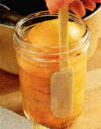 liquid while still leaving the recommended head space. Also be sure to remove trapped air bubbles with a slim rubber scraper, spatula or kitchen knife. To do this effectively, tilt the jar slightly while running the tool between the fruit and the edge of the jar and also pressing inward against the fruit a few times. liquid while still leaving the recommended head space. Also be sure to remove trapped air bubbles with a slim rubber scraper, spatula or kitchen knife. To do this effectively, tilt the jar slightly while running the tool between the fruit and the edge of the jar and also pressing inward against the fruit a few times.Canned peaches, pears and apples may show a blue, red or pink color change after processing. This is sometimes the result of natural chemical changes that occur as fruits are heated. A spatula-shaped wooden spoon that has a flat end instead of rounded, is good to have for stirring sugar syrup in a flat bottomed pan during the cooking process. Avoid storing canned food near a furnace, water heater or hot water pipes. Jars need to be kept cool for longer storage life and to protect against spoilage. Be sure to store in a dry place. Rusting of the lid or band can cause seal to break. To avoid freezing in extremely cold storage environments, wrap canned jars with newspaper and place in heavy cardboard boxes. Cover boxes with a heavy cloth of blanket if necessary. |
|
||
To prepare syrup, while heating water, add sugar slowly, stirring constantly to dissolve. Bring to a gentle boil. Fill jars while syrup is still boiling hot. Peaches | Apricots | Berries | Cherries | Grapefruit Pears | Plumbs | Blackberries | Raspberries | Elderberries Gooseberries | Huckleberries Top of Page Yes, leaving the specified amount of head space in a jar is allows a vacuum seal during processing. If too little head space is allowed the food may expand and bubble out when air is being forced out from under the lid during processing. The bubbling food may leave a deposit on the rim of the jar or the seal of the lid and prevent the jar from sealing properly If too much head space is allowed, the food at the top is likely to dis-color and jars may not seal. How long will canned food keep? Properly canned food stored in a cool, dry place will retain optimum eating quality for at least 1 year. Canned food stored in a warm place near hot pipes, a range, a furnace, or in indirect sunlight may lose some of its eating quality in a few weeks or months, depending on the temperature. Dampness may corrode bands or metal lids and cause leakage which will spoil the contents. Do jars need to be sterilized before processing? Jars do not need to be sterilized before canning if they will be filled with food and processed in a boiling water bath canner for 10 minutes or more or if they will be processed in a pressure canner, however it is good practice to take the extra time and sterilize anyway. You can never be too careful when it comes to food safety. Jars that will be processed in a boiling water bath kettle for less than 10 minutes need to be sterilized by boiling them in hot water for 10 minutes before they're filled. Is it safe to use an oven for food processing? No. This can be dangerous because the temperature will vary according to the accuracy of oven regulators and circulation of heat. Dry heat is very slow in penetrating into jars of food. Also, jars explode easily in the oven. Why do you have to exhaust a pressure canner? If the pot is not exhausted, the inside temperature may not correspond to the pressure on the gauge. Steam should be allowed to escape for 10 minutes before closing the valve. Should liquid lost during processing be replaced? No. Loss of liquid does not cause food to spoil, though the food above the liquid may darken. Is it all right to reuse jar lids and bands? Lids should never be used a second time since the sealing compound becomes indented by the first use, preventing another airtight seal. Screw bands may be reused unless they are badly rusted or the top edge is pried up which would prevent a proper seal. Is it safe to use the open kettle canning method? No. In open kettle canning, food is cooked in an ordinary kettle, then packed into hot jars and sealed without processing. The temperatures obtained in open kettle canning are not hot enough to kill all the dangerous microorganisms in the food. Contamination may also occur during the transferring of food from the kettle into the jars. What causes the undersides of jar lids to dis-color? Natural compounds in some foods, particularly acids, corrode metal and make a dark deposit on the underside of jar lids. This deposit is harmless providing the jar has a good seal and the contents have been properly processed. Why do jars break during processing? Canning jars will break for several reasons:
This can be oftentimes be accomplished by soaking jars for several hours in a solution of 1 cup vinegar and 1 gallon of water. Questions About Canning Vegetables and Fruits Is it safe to can food without salt? Yes. Salt is used for flavor only and is not necessary to prevent spoilage. Is it safe to can fruits without sugar? Yes. Sugar is added to improve flavor, help stabilize color, and retain the shape of the fruit. It is not added as a preservative. Can fruits and vegetables be canned without heating if aspirin is used? No. Aspirin should not be used in canning. It cannot be relied on to prevent spoilage or to give satisfactory products. Adequate heat treatment is the only safe procedure. Is it safe to can green beans in a boiling water bath if vinegar is used? No. Recommended processing methods must be used to assure safety. Recommended processing times cannot be shortened if vinegar is used in canning fresh vegetables (this does not refer to pickled vegetables). Should all vegetables be precooked before canning? For best quality, yes. However, some vegetables can be packed raw or cold into jars before being processed in the pressure canner. What vegetables expand instead of shrink during processing? Corn, peas and lima beans are starchy and expand during processing. They should be packed loosely. What causes corn to turn brown during processing? This occurs most often when too high a temperature is used causing caramelization of the sugar in the corn. It may also be caused by some minerals in the water used in canning. Questions About Canning Meats Should giblets of chicken be canned in the same jar with chicken? No. Their flavor may permeate other pieces of chicken in the jar. Is it safe to can meat and poultry without salt? Yes. Salt is used for flavor only and is not necessary for safe processing. 5 Star Customer Rated Ball Blue Book of Preserving Seed to Seed Canning & Preserving for Dummies |
|||
|
|||
|
Visit our Italian Gourmet Cookery Canning Index | email | FAQ's | Glossary Cooking Terms |Recipe Software | Canning Store Canning Cookbooks | Preserving Fruit | Canning Tomatoes © Copyright canning-food-recipes.com/ canning fruit 1997-2008 |
|||
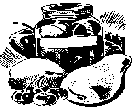 |
||
|
||
Steel Food Mill  Read more/Pricing/Ordering |
||
Pressure Canner 19-pint or 7-quart jar capacity 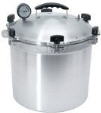 Read more/Pricing/Ordering |
||
Basics Kit 7-quart Jar Canner 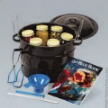 Read more/Pricing/Ordering 
|